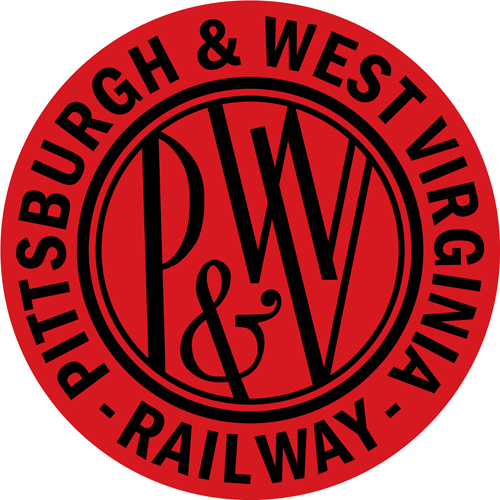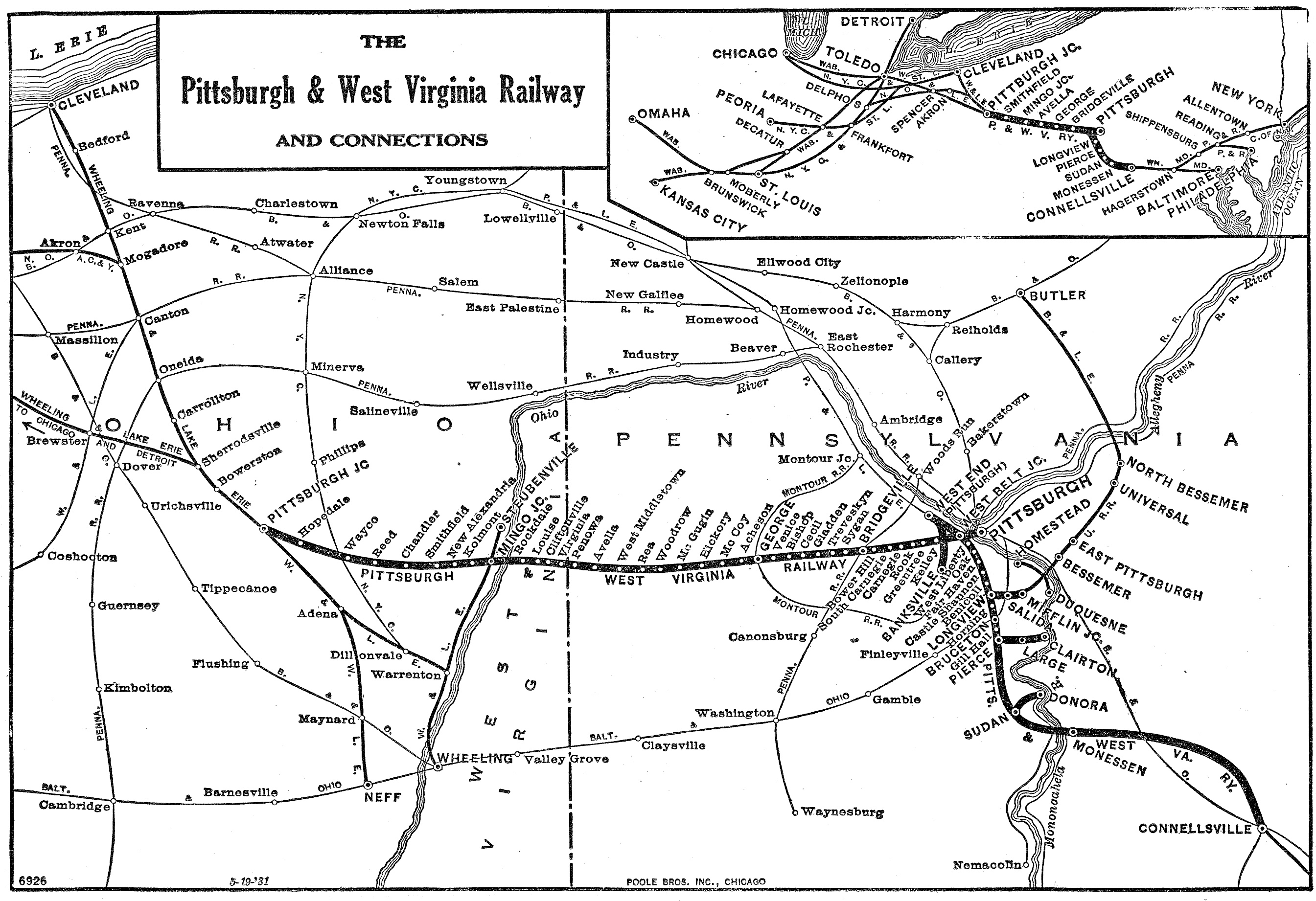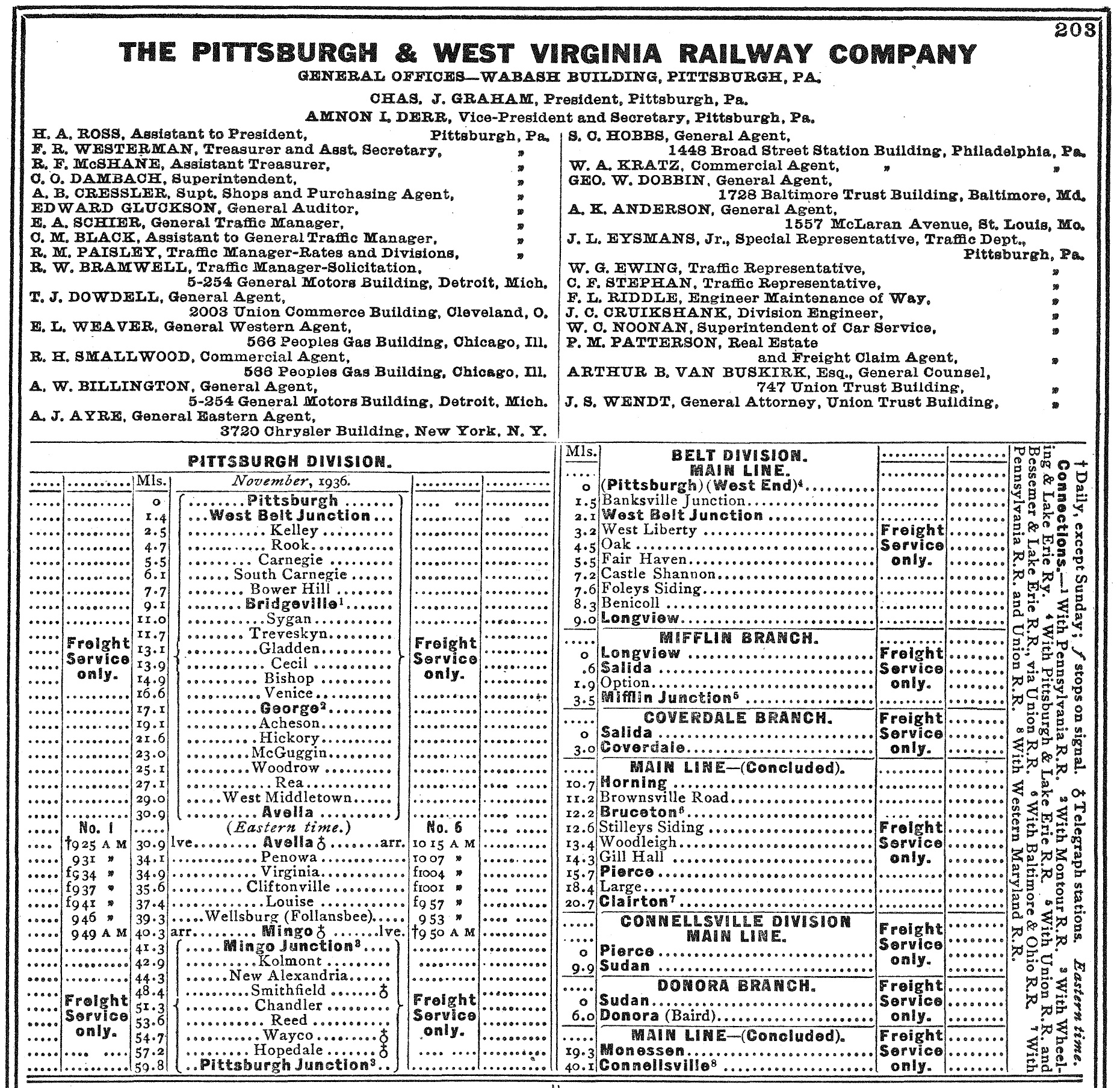Pittsburgh and West Virginia Railway: Map, Rosters, History
Last revised: August 23, 2024
By: Adam Burns
Ironically, the P&WV was a relative latecomer to the industry; much of its network was not constructed until after 1900 and the road only truly came of age during the 1930s.
The Pittsburgh and West Virginia Railway was another western Pennsylvania/northern Ohio system serving Pittsburgh's once prolific steel industry.
As a result it moved considerable coal, coke, and iron ore. However, the railroad is perhaps best remembered for its status as a bridge line and member of the famous "Alphabet Route."
This marketing endeavor was a chain of smaller railroads, which competed with the large eastern trunk lines (Pennsylvania, New York Central, and Baltimore & Ohio) for lucrative merchandise freight between the hotly contested New York-Chicago corridor.
The concept was actually quite successful for many years until mergers made the entire operation obsolete. Today, virtually the entire P&WV main line from Connellsville to Pittsburgh Junction survives as a key route for the reborn Wheeling & Lake Erie Railway, a profitable Class II startup of the early 1990s.
Photos
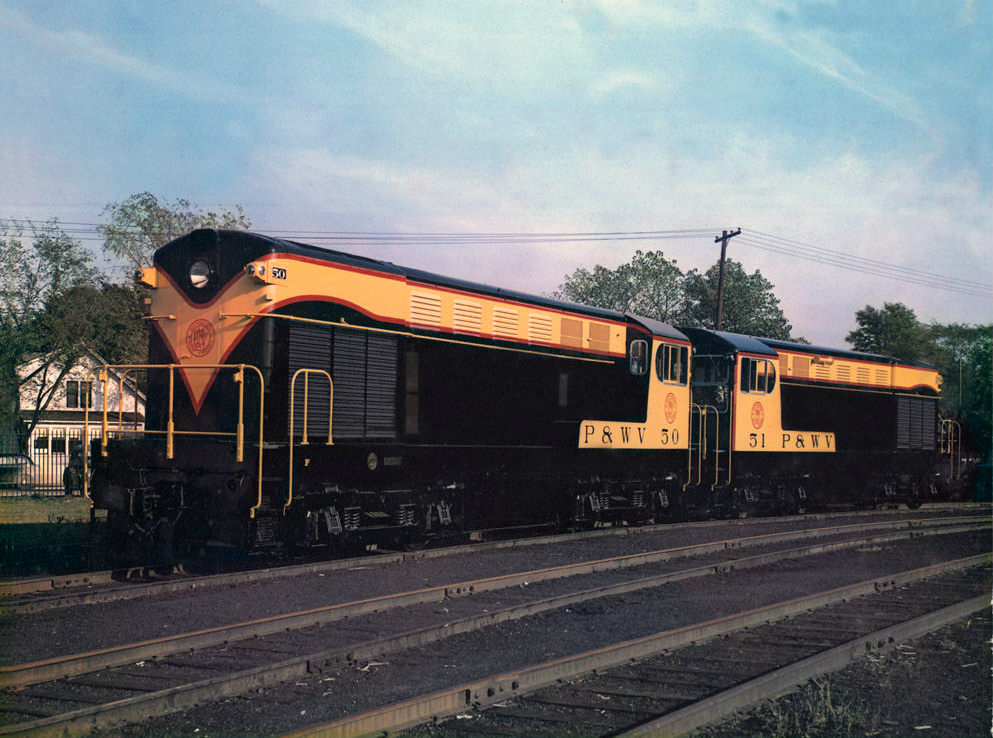 Seen here are new Pittsburgh & West Virginia H20-44's, #50-51, in October, 1947. American-Rails.com collection.
Seen here are new Pittsburgh & West Virginia H20-44's, #50-51, in October, 1947. American-Rails.com collection.History
The Pittsburgh and West Virginia Railway began as a dream of the Gould interests, launched by father Jay and carried on through son George, to complete the holy grail of railroading, a true coast-to-coast transcontinental system.
They nearly accomplished the feat except for a small unfinished section between Pittsburgh and Connellsville, Pennsylvania.
From west to east their portfolio included the Western Pacific, Rio Grande Western/Denver & Rio Grande, Missouri Pacific, Wabash Railroad, Wheeling & Lake Erie, Wabash-Pittsburgh Terminal Railway, and the Western Maryland.
The immediate history of the P&WV begins with the Wabash-Pittsburgh Terminal (W-PT), formed on May 9, 1904 as a consolidation of several smaller systems Gould had launched to build across Pennsylvania, pass through the Northern Panhandle of West Virginia, and link up with the Wheeling & Lake Erie at Pittsburgh Junction, Ohio.
At A Glance
Pittsburgh - Pittsburgh Junction, Ohio Pittsburgh - Longview (Belt Division) Longview - Mifflin Junction (Mifflin Branch) Salida - Cloverdale (Cloverdale Branch) Horning - Clairton Pierce - Sudan Sudan - Donora Monessen - Connellsville | |
Expansion
These small roads included the Cross Creek Railroad (chartered in Ohio on April 23, 1900); Pittsburgh, Toledo & Western (formed on April 3, 1901 in West Virginia), and the Pittsburgh, Carnegie & Western (created on July 17, 1901 in Pennsylvania).
All three projects began construction almost simultaneously and within a few years were ready for service from Pittsburgh to Pittsburgh Junction, Ohio (63.31 miles).
According to the article, "Middleman Of The Alphabet Route," by Gus Welty from the November, 1956 issue of Trains Magazine, the W-PT operated its first train on June 1, 1904.
It also constructed an elaborate passenger terminal in downtown Pittsburgh which opened on April 13, 1904. Known as the Wabash Pittsburgh Terminal it was designed in the Beaux-Arts style by architect Theodore Carl Link featuring eleven stories and a beautiful dome set upon the roof.
Logo
It was constructed at a cost of $800,000 and served in its original capacity until 1931 and later razed in 1953-1954. Aside from his long range plans, Gould's WP-T moved substantial freight related to the steel industry through his partnership with Andrew Carnegie.
The steel tycoon had been involved in a longstanding battle with the Pennsylvania Railroad regarding freight rates. As a result, he worked with Gould's railroad, as well as his own Union Railroad, to move raw materials and finished products.
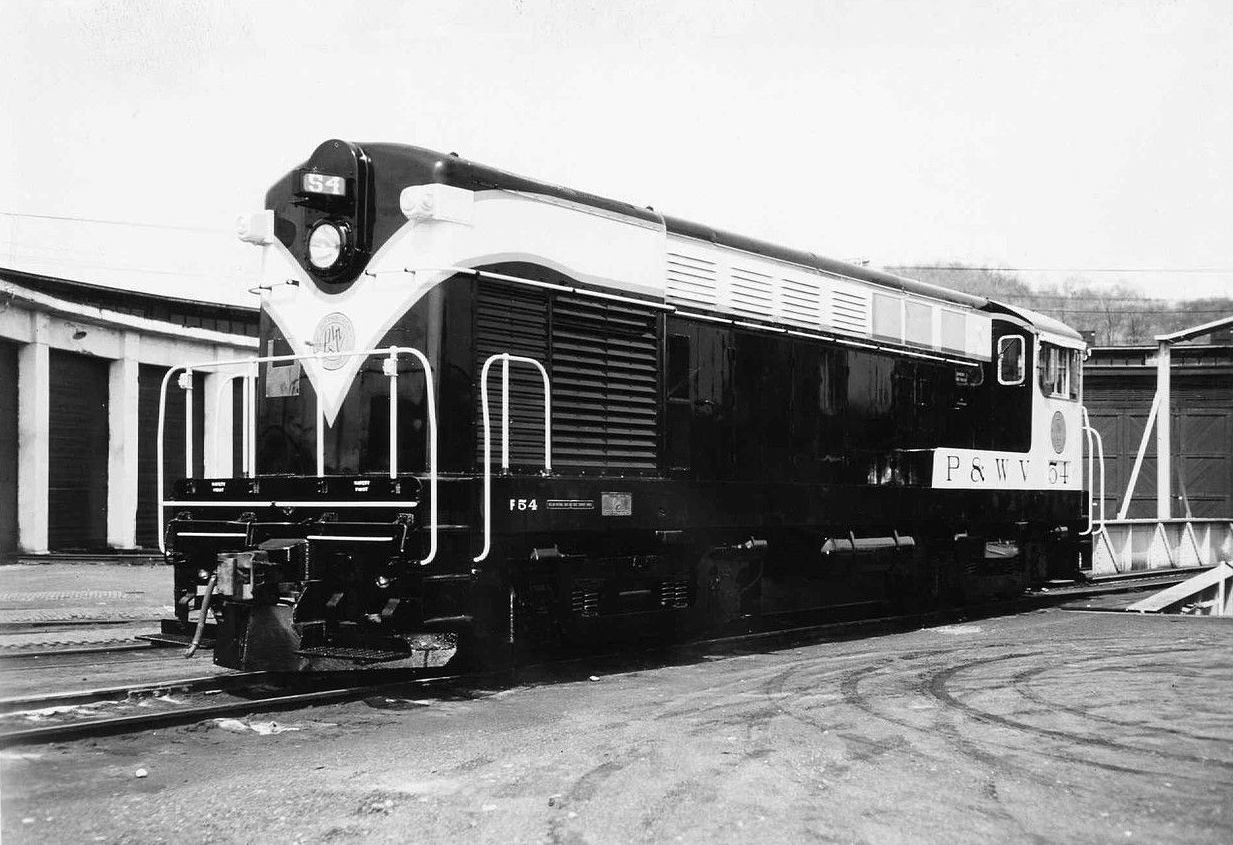 A Pittsburgh & West Virginia Railway company photo featuring new H20-44 #54 during early 1951. The P&WV purchased almost exclusively FM products while a few other diesels from Baldwin rounded out its roster.
A Pittsburgh & West Virginia Railway company photo featuring new H20-44 #54 during early 1951. The P&WV purchased almost exclusively FM products while a few other diesels from Baldwin rounded out its roster.Carnegie also had an interest in the Pittsburgh & Lake Erie, which acted in a similar fashion to the WP-T by handling heavy steel-related tonnage from Pittsburgh to northeastern Ohio. The P&LE eventually became a profitable arm of the New York Central.
Over time the PRR and Carnegie worked out their differences. Unfortunately the financial Panic of 1907 ended Gould's transcontinental dreams as bankruptcy caused him to lose the properties under his control.
This included the Wabash-Pittsburgh Terminal, which entered receivership on May 29, 1908. As Mr. Welty points out the railroad emerged on January 29, 1917 as the Pittsburgh & West Virginia Railway, an independent company which would remain so for another 47 years.
For nearly two decades it remained relatively profitable but had little success in accomplishing its goal of opening an eastern outlet.
Finally, under a project started by Frank Taplin in the 1920s this initiative was achieved. Interestingly, Taplin's lofty vision was to see the P&WV merge with the Wheeling & Lake Erie, Western Maryland, Wabash, and Lehigh Valley to produce an eastern trunk line rivaling the Baltimore & Ohio, Erie, PRR, and New York Central.
System Map (1940)
Unfortunately, his dream was shot down by the Interstate Commerce Commission although one component of the idea was completed, an extension from Pierce, Pennsylvania to Connellsville opening in the spring of 1931 (in 1928 it also gained control of the small West Side Belt Railroad, connecting Pittsburgh with Clairton).
This provided it a connection with the WM and the two went on to form part of the "Alphabet Route," a group of eight railroads offering high-speed freight service from Chicago to New England.
The others comprising the group included Lehigh & Hudson River, New Haven, Nickel Plate, W&LE, Reading, and Central Railroad of New Jersey.
By the 1930s the P&WV handled a variety of freight from hotshot merchandise trains (the "Alpha Jet" symbol trains included MS-1 [the Michigan Steeler] with eastbound runs AJ-4, AJ-12, AJ-2, and westbound consists including AJ-1, AJ-3, and BT-1) to coal, coke, and iron.
That decade also witnessed the railroad upgraded with centralized traffic control (CTC) for more efficient and safe operations. It contained a total of 152 route miles.
In 1955 it carried an operating revenue of $8.6 million of which $873,970 was net income. The decade also witnessed the road's transition to diesels, completed in 1953. Its motive power was unique for a Class I of that time, relying almost exclusively on the opposed-piston designs of Fairbanks-Morse.
FM was a relative newcomer to the railroad market although it had built marine engines, quite successfully, for many years. The diesels, though, were never as impressive as the road's steam fleet which consisted of some very large arrangements given the road's small size.
Timetables (1940)
There were handy 2-8-0's, 4-6-2's, and 2-8-2's as well as the P&WV's biggest power, mammoth 2-6-6-4's. The latter were a small fleet of seven built by the Baldwin Locomotive Works between 1934 and 1937 offering an impressive 97,500 pounds of tractive effort.
The articulateds were normally used between South Pittsburgh's Rook Yard and Connellsville where the worst grades were located.
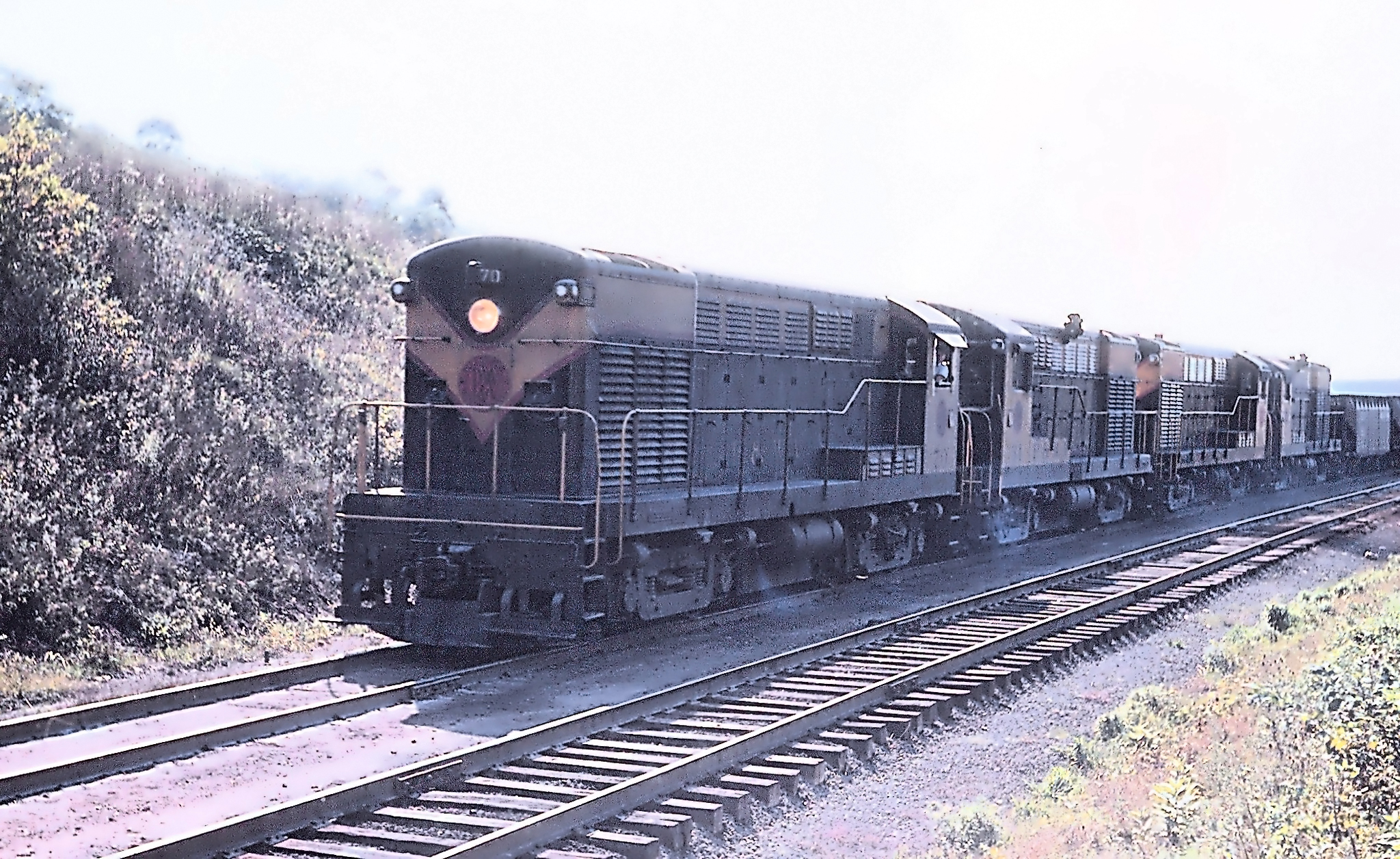 A group of Pittsburgh & West Virginia's rugged H20-44s at Rook, Pennyslvania; October, 1960. Roger Puta photo.
A group of Pittsburgh & West Virginia's rugged H20-44s at Rook, Pennyslvania; October, 1960. Roger Puta photo.Final Years
In 1964 the Pittsburgh & West Virginia lost its independence when it was leased by the Norfolk & Western on October 16th that year. The N&W spent much of that decade gobbling up other systems.
Three years later the Pittsburgh and West Virginia Railroad was set up by the N&W as a real estate trust to acquire ownership of the P&WV property, effectively relegating it to the history books.
Diesel Roster
Baldwin Locomotive Works
| Model Type | Road Number | Date Built | Quantity |
|---|---|---|---|
| VO-1000 | 30 | 9/13/1943 | 1 |
| AS616 | 40 | 5/23/1951 | 1 |
Fairbanks-Morse
| Model Type | Road Number | Date Built | Quantity |
|---|---|---|---|
| H20-44 | 50-71 | 1947-1953 | 22 |
| H16-44 | 90-93 | 1956-1957 | 4 |
Steam Roster
| Class | Road Number(s) | Wheel Arrangement | Tractive Effort | Builder/Date |
|---|---|---|---|---|
| B-1 | 20 | 0-6-0 | 39,100 Lbs | Alco, 1919 |
| G-4 | 910, 912, 914, 917, 919 | 2-8-0 | 58,620 Lbs | Alco, 1909 |
| G-5 | 920-922 | 2-8-0 | 58,620 Lbs | Alco, 1918 |
| G-6 | 923-928 | 2-8-0 | 58,620 Lbs | Alco, 1921 |
| G-7* | 402 | 2-8-0 | 53,197 Lbs | Pennsylvania/Juniata Shops, 1908 |
| G-7* | 405 | 2-8-0 | 53,197 Lbs | Baldwin, 1910 |
| G-8** | 950-951 | 2-8-0 | 60,484 Lbs | Alco, 1913 |
| H-5*** | 1010 | 2-8-2 | 65,724 Lbs | Alco, 1918 |
| H-6 | 1000-1002 | 2-8-2 | 65,724 Lbs | Baldwin, 1918 |
| H-7**** | 1050-1053 | 2-8-2 | 62,949 Lbs | Alco, 1918 |
| K-1 | 200 | 4-6-2 | 25,257 Lbs | Alco, 1921 |
| K-2 | 202 | 4-6-2 | 25,257 Lbs | Alco, 1924 |
| J-1 | 1100-1102 | 2-6-6-4 | 97,500 Lbs | Baldwin, 1934 |
| J-2 | 1103-1106 | 2-6-6-4 | 97,500 Lbs | Baldwin, 1936-1937 |
* Ex-Detroit, Toledo & Ironton
** Ex-Wheeling & Lake Erie
*** Ex-Chicago, Indianapolis & Louisville (Monon)
**** Ex-Central Railroad Of New Jersey
All of the above information concerning the P&WV's steam locomotive roster is courtesy of Gus Welty's, "Middleman Of The Alphabet Route," from the November, 1956 issue of Trains.
The road's two Pacifics had been assigned to freight service after the P&WV discontinued passenger trains in 1931.
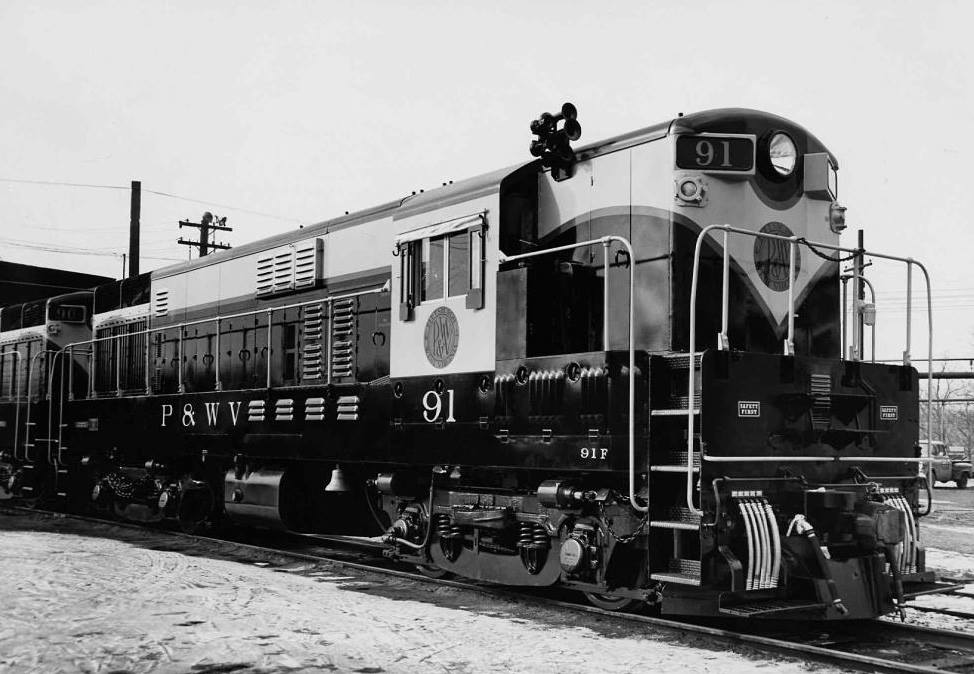 Pittsburgh & West Virginia H16-44's #90 and #91, circa late 1956/early 1957, following delivery from Fairbanks-Morse.
Pittsburgh & West Virginia H16-44's #90 and #91, circa late 1956/early 1957, following delivery from Fairbanks-Morse.In an interesting twist the P&WV still lives on today. The N&W retained virtually all of the railroad’s routes upon purchase and when the N&W’s successor, Norfolk Southern, spun-off the P&WV’s lines in 1990 to the new Wheeling & Lake Erie Railway they have become a very important corridor under the W&LE.
Today the Wheeling and Lake Erie Railway is going as strong as ever with a traffic base in coal, iron ore, steel, aggregates, plastics, chemicals, forest products, and grain! The Conrail breakup has also allowed it to dabble into the profitable intermodal business.
Because of this, coupled with a strong management team extremely dedicated to not only the railroad’s success but also its future growth, things are looking as bright as ever on the W&LE.
If you are interested in visiting the Wheeling and Lake Erie Railway its east-west main line runs between Bellevue, Ohio and Pittsburgh. However, the "hub" of the railroad’s operations continues to remain in Brewster, as it has when since the railroad began in 1871.
Recent Articles
-
New Hampshire Dinner Train Rides In N. Conway!
Jan 16, 26 10:47 AM
Tucked into the heart of New Hampshire’s Mount Washington Valley, the Conway Scenic Railroad is one of New England’s most beloved heritage railways -
Oregon Dinner Train Rides Near Mt. Hood!
Jan 16, 26 10:44 AM
The Mt. Hood Railroad is the moving part of that postcard—a century-old short line that began as a working railroad. -
Maryland's - Wine Tasting - Train Rides
Jan 15, 26 02:59 PM
This article delves into the enchanting world of wine tasting train experiences in Maryland, providing a detailed exploration of their offerings, history, and allure. -
Colorado's - Wine Tasting - Train Rides
Jan 15, 26 02:46 PM
To truly savor these local flavors while soaking in the scenic beauty of Colorado, the concept of wine tasting trains has emerged, offering both locals and tourists a luxurious and immersive indulgenc… -
Iowa ~ Wine Tasting ~ Train Rides
Jan 15, 26 02:36 PM
The state not only boasts a burgeoning wine industry but also offers unique experiences such as wine by rail aboard the Boone & Scenic Valley Railroad. -
Georgia's Wine Train Rides In Cordele!
Jan 15, 26 02:26 PM
While the railroad offers a range of themed trips throughout the year, one of its most crowd-pleasing special events is the Wine & Cheese Train—a short, scenic round trip designed to feel like a t… -
Indiana ~ Murder Mystery ~ Dinner Train Rides
Jan 15, 26 02:22 PM
This piece explores the allure of murder mystery trains and why they are becoming a must-try experience for enthusiasts and casual travelers alike. -
Ohio ~ Murder Mystery ~ Dinner Train Rides
Jan 15, 26 02:10 PM
The murder mystery dinner train rides in Ohio provide an immersive experience that combines fine dining, an engaging narrative, and the beauty of Ohio's landscapes. -
Nevada Dinner Train Rides In Ely!
Jan 15, 26 02:01 PM
If you’ve ever wished you could step through a time portal into the hard-working world of a 1900s short line the Nevada Northern Railway in Ely is about as close as it gets. -
Michigan Dinner Train Rides In Owosso!
Jan 15, 26 09:46 AM
The Steam Railroading Institute is best known as the home of Pere Marquette #1225 and even occasionally hosts a dinner train! -
Arizona's - Wine Tasting - Train Rides
Jan 14, 26 02:04 PM
For those who want to experience the charm of Arizona's wine scene while embracing the romance of rail travel, wine tasting train rides offer a memorable journey through the state's picturesque landsc… -
Arkansas's - Wine Tasting - Train Rides
Jan 14, 26 01:57 PM
This article takes you through the experience of wine tasting train rides in Arkansas, highlighting their offerings, routes, and the delightful blend of history, scenery, and flavor that makes them so… -
Tennessee ~ Murder Mystery ~ Dinner Train Rides
Jan 14, 26 01:42 PM
Amidst the rolling hills and scenic landscapes of Tennessee, an exhilarating and interactive experience awaits those with a taste for mystery and intrigue. -
California ~ Murder Mystery ~ Dinner Train Rides
Jan 14, 26 01:26 PM
When it comes to experiencing the allure of crime-solving sprinkled with delicious dining, California's murder mystery dinner train rides have carved a niche for themselves among both locals and touri… -
Illinois ~ Murder Mystery ~ Dinner Train Rides
Jan 14, 26 01:13 PM
Among Illinois's scenic train rides, one of the most unique and captivating experiences is the murder mystery excursion. -
Vermont's - Murder Mystery - Dinner Train Rides
Jan 14, 26 12:57 PM
There are currently murder mystery dinner trains offered in Vermont but until recently the Champlain Valley Dinner Train offered such a trip! -
Massachusetts Dinner Train Rides On Cape Cod!
Jan 14, 26 12:20 PM
The Cape Cod Central Railroad (CCCR) has carved out a special niche by pairing classic New England scenery with old-school hospitality, including some of the best-known dining train experiences in the… -
Maine Dinner Train Rides In Portland!
Jan 14, 26 11:31 AM
While this isn’t generally a “dinner train” railroad in the traditional sense—no multi-course meal served en route—Maine Narrow Gauge does offer several popular ride experiences where food and drink a… -
Kentucky Dinner Train Rides In Bardstown!
Jan 13, 26 01:14 PM
The essence of My Old Kentucky Dinner Train is part restaurant, part scenic excursion, and part living piece of Kentucky rail history. -
Kansas Dinner Train Rides In Abilene!
Jan 13, 26 12:44 PM
If you’re looking for a heritage railroad that feels authentically Kansas—equal parts prairie scenery, small-town history, and hands-on railroading—the Abilene & Smoky Valley Railroad (A&SV) delivers. -
Michigan ~ Murder Mystery ~ Dinner Train Rides
Jan 13, 26 11:24 AM
Among the lesser-known treasures of this state are the intriguing murder mystery dinner train rides—a perfect blend of suspense, dining, and scenic exploration. -
Virginia's - Murder Mystery - Dinner Train Rides
Jan 13, 26 11:11 AM
Among the state's railroad attractions, murder mystery dinner trains stand out as a captivating fusion of theatrical entertainment, fine dining, and scenic travel. -
Arizona Dinner Train Rides At The Grand Canyon!
Jan 13, 26 10:59 AM
While the Grand Canyon Railway does not offer a true, onboard dinner train experience it does offer several upscale options and off-train dining. -
Georgia Dinner Train Rides In Nashville!
Jan 13, 26 10:27 AM
If you’ve ever wished you could slow down, trade traffic for jointed rail, and let a small-town landscape roll by your window while a hot meal is served at your table, the Azalea Sprinter delivers tha… -
Indiana Valentine's Train Rides
Jan 12, 26 04:27 PM
If you’ve ever wished you could step into a time when passenger trains were a Saturday-night treat and a whistle echoing across farm fields meant “adventure,” the Nickel Plate Express delivers that fe… -
Ohio Valentine's Train Rides!
Jan 12, 26 04:20 PM
The Hocking Valley Scenic Railway offers one of the region’s most atmospheric ways to experience the Hocking Hills area: from the rhythmic click of jointed rail to the glow of vintage coaches rolling… -
Wisconsin's - Wine Tasting - Train Rides
Jan 12, 26 03:10 PM
Wisconsin might not be the first state that comes to mind when one thinks of wine, but this scenic region is increasingly gaining recognition for its unique offerings in viticulture. -
California's - Wine Tasting - Train Rides
Jan 12, 26 02:34 PM
This article explores the charm, routes, and offerings of these unique wine tasting trains that traverse California’s picturesque landscapes. -
Wisconsin Scenic Train Rides In North Freedom!
Jan 12, 26 02:20 PM
The Mid-Continent Railway Museum is a living-history museum built around the sights, sounds, and everyday rhythms of small-town and shortline railroading in the early 20th century, what the museum cal… -
Vermont Scenic Train Rides In Burlington!
Jan 12, 26 01:18 PM
Today, GMRC is best known by many travelers for its Burlington-based passenger experiences—most famously the Champlain Valley Dinner Train and the sleek, limited-capacity Cocktails on the Rails. -
Maryland's - Murder Mystery - Dinner Train Rides
Jan 12, 26 01:03 PM
Maryland is known for its scenic landscapes, historical landmarks, and vibrant culture, but did you know that it’s also home to some of the most thrilling murder mystery dinner trains? -
Minnesota's - Murder Mystery - Dinner Train Rides
Jan 12, 26 12:17 PM
Murder mystery dinner trains offer an enticing blend of suspense, culinary delight, and perpetual motion, where passengers become both detectives and dining companions on an unforgettable journey. -
Vermont Dinner Train Rides In Burlington!
Jan 12, 26 12:09 PM
There is one location in Vermont hosting a dedicated dinner train experience at the Green Mountain Railroad. -
Connecticut Dinner Train Rides In Essex!
Jan 12, 26 10:39 AM
Connecticut's rail heritage can be traced back to the industry's earliest days and a few organizations preserve this rich history by offering train rides. The Essex Steam Train also hosts dinner-theme… -
Florida Scenic Train Rides In Parrish!
Jan 11, 26 10:26 PM
The Florida Railroad Museum (FRRM) in Parrish offers something increasingly rare in today’s rail landscape: a chance to ride historic equipment over a surviving fragment of an early-20th-century mainl… -
California's - Wine Tasting - Train Rides
Jan 11, 26 02:28 PM
This article explores the charm, routes, and offerings of these unique wine tasting trains that traverse California’s picturesque landscapes. -
Georgia's - Murder Mystery - Dinner Train Rides
Jan 11, 26 02:07 PM
In the heart of the Peach State, a unique form of entertainment combines the thrill of a murder mystery with the charm of a historic train ride. -
Colorado ~ Murder Mystery ~ Dinner Train Rides
Jan 11, 26 01:43 PM
Nestled among the breathtaking vistas and rugged terrains of Colorado lies a unique fusion of theater, gastronomy, and travel—a murder mystery dinner train ride. -
Minnesota Dinner Train Rides In Duluth!
Jan 11, 26 01:32 PM
One of the best ways to feel the region's history in motion today is aboard the North Shore Scenic Railroad (NSSR), which operates out of Duluth’s historic depot. -
Illinois Dinner Train Rides At Monticello!
Jan 11, 26 12:42 PM
The Monticello Railway Museum (MRM) is one of those places that quietly does a lot: it preserves a sizable collection, maintains its own operating railroad, and—most importantly for visitors—puts hist… -
Alabama's - Wine Tasting - Train Rides
Jan 10, 26 09:29 AM
While the state might not be the first to come to mind when one thinks of wine or train travel, the unique concept of wine tasting trains adds a refreshing twist to the Alabama tourism scene. -
Maryland Dinner Train Rides At WMSR!
Jan 10, 26 09:13 AM
The Western Maryland Scenic Railroad (WMSR) has become one of the Mid-Atlantic’s signature heritage operations—equal parts mountain railroad, living museum, and “special-occasion” night out. -
Arkansas Dinner Train Rides On The A&M!
Jan 10, 26 09:11 AM
If you want a railroad experience that feels equal parts “working short line” and “time machine,” the Arkansas & Missouri Railroad (A&M) delivers in a way few modern operations can. -
South Dakota's - Murder Mystery - Dinner Train Rides
Jan 10, 26 09:08 AM
While the state currently does not offer any murder mystery dinner train rides, the popular "1880 Train" at the Black Hills Central recently hosted these popular trips! -
Wisconsin's - Murder Mystery - Dinner Train Rides
Jan 10, 26 09:07 AM
Whether you're a fan of mystery novels or simply relish a night of theatrical entertainment, Wisconsin's murder mystery dinner trains promise an unforgettable adventure. -
Missouri's - Murder Mystery - Dinner Train Rides
Jan 10, 26 09:05 AM
Missouri, with its rich history and scenic landscapes, is home to one location hosting these unique excursion experiences. -
Washington ~ Murder Mystery ~ Dinner Train Rides
Jan 10, 26 09:04 AM
This article delves into what makes murder mystery dinner train rides in Washington State such a captivating experience. -
Kentucky Scenic Train Rides At KRM!
Jan 09, 26 11:13 PM
Located in the small town of New Haven the Kentucky Railway Museum offers a combination of historic equipment and popular excursions. -
Washington "Wine Tasting" Train Rides
Jan 09, 26 08:53 PM
Here’s a detailed look at where and how to ride, what to expect, and practical tips to make the most of wine tasting by rail in Washington. -
Kentucky's - Wine Tasting - Train Rides
Jan 09, 26 08:21 PM
Kentucky, often celebrated for its rolling pastures, thoroughbred horses, and bourbon legacy, has been cultivating another gem in its storied landscapes; enjoying wine by rail.

